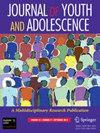The Time-Varying Association Between Family Climate and Adolescent School Adjustment From 4th Grade to 12th Grade.
IF 3.6
1区 心理学
Q1 PSYCHOLOGY, DEVELOPMENTAL
引用次数: 0
Abstract
Family climate and adolescents' school adjustment are closely related. However, little is known about the developmental timing of "when" and "how" their associations change across grade levels. Using time-varying effect modeling (TVEM), this study aimed to examine the dynamic associations between family climate and school adjustment from early to middle adolescence. The sample consisted of 15,451 adolescents in 4th to 12th grades, aged 9 to 18 years (M = 13.33, SD = 2.24); 52.2% were boys and 47.8% were girls; 25.5% were only children, while 74.5% had at least one sibling; 93.9% were from married-parent families, and 6.1% were from families with other structures. Results revealed that family cohesion and conflict were significantly associated with school connectedness and academic achievement across 4th to 12th grades, with the associations being stronger in middle school grades. Family cohesion also significantly moderated how family conflict related to school adjustment, supporting the "mattering" hypothesis rather than the "buffering" hypothesis. Specifically, family conflict had stronger negative associations with school connectedness among adolescent from high-cohesion families than those from low-cohesion families, particularly during the transition grades from middle to high school (9th to 10th grades). Family conflict also had a significant negative association with academic achievement in 4th to 9th graders from high-cohesion families, but such association was not significant for adolescents in low-cohesion families. Findings demonstrated the time-varying association between family climate and school adjustment across adolescence, with middle school being a critical time window for family-school intervention. Moreover, fostering a cohesive family climate, especially during key school transitions, may be an effective way to support adolescents' academic success and overall adjustment.四年级至十二年级青少年家庭氛围与学校适应的时变关系
家庭氛围与青少年的学校适应密切相关。然而,关于“何时”和“如何”它们的关联在不同年级发生变化的发展时间知之甚少。本研究采用时变效应模型(TVEM),探讨青少年早期至中期家庭氛围与学校适应之间的动态关系。样本包括15,451名9至18岁的4至12年级青少年(M = 13.33, SD = 2.24);男生占52.2%,女生占47.8%;25.5%是独生子女,74.5%至少有一个兄弟姐妹;93.9%来自已婚家庭,6.1%来自其他结构家庭。结果显示,在四年级到十二年级,家庭凝聚力和冲突与学校联系和学业成绩显著相关,在中学阶段这种关联更强。家庭凝聚力也显著调节家庭冲突与学校适应的关系,支持“重要”假说而非“缓冲”假说。具体而言,高凝聚力家庭的青少年比低凝聚力家庭的青少年家庭冲突与学校联系有更强的负相关,特别是在从初中到高中的过渡年级(9年级到10年级)。家庭冲突对高凝聚力家庭4 ~ 9年级学生的学业成绩也有显著的负相关,而对低凝聚力家庭的青少年则不显著。研究结果表明,家庭氛围与学校适应之间存在着随时间变化的关系,其中中学阶段是家庭-学校干预的关键时间窗口。此外,培养一个有凝聚力的家庭氛围,特别是在关键的学校过渡期间,可能是支持青少年学业成功和整体适应的有效途径。
本文章由计算机程序翻译,如有差异,请以英文原文为准。
求助全文
约1分钟内获得全文
求助全文
来源期刊

Journal of Youth and Adolescence
PSYCHOLOGY, DEVELOPMENTAL-
CiteScore
8.20
自引率
6.10%
发文量
155
期刊介绍:
Journal of Youth and Adolescence provides a single, high-level medium of communication for psychologists, psychiatrists, biologists, criminologists, educators, and researchers in many other allied disciplines who address the subject of youth and adolescence. The journal publishes quantitative analyses, theoretical papers, and comprehensive review articles. The journal especially welcomes empirically rigorous papers that take policy implications seriously. Research need not have been designed to address policy needs, but manuscripts must address implications for the manner society formally (e.g., through laws, policies or regulations) or informally (e.g., through parents, peers, and social institutions) responds to the period of youth and adolescence.
 求助内容:
求助内容: 应助结果提醒方式:
应助结果提醒方式:


